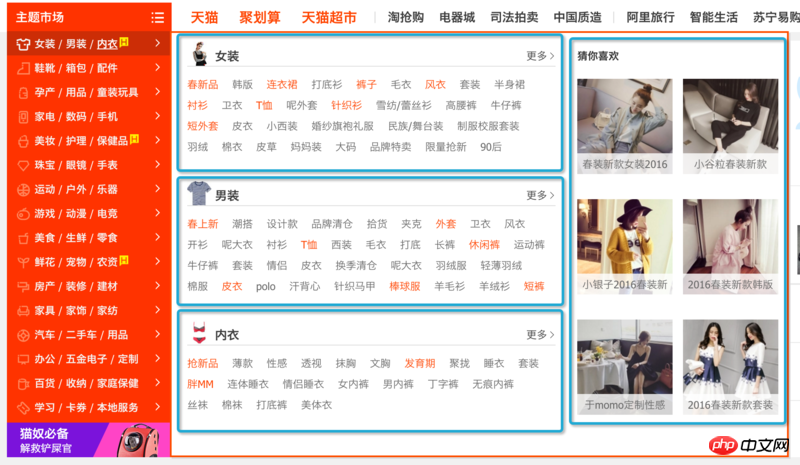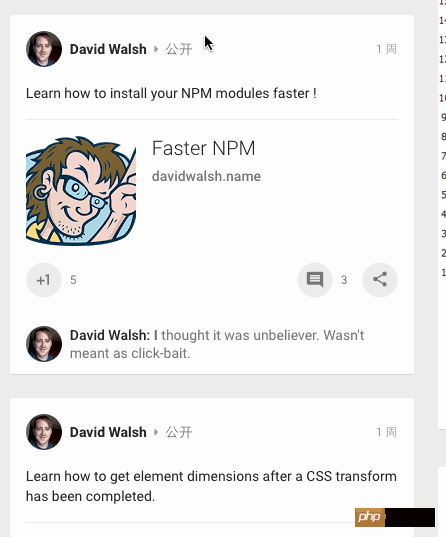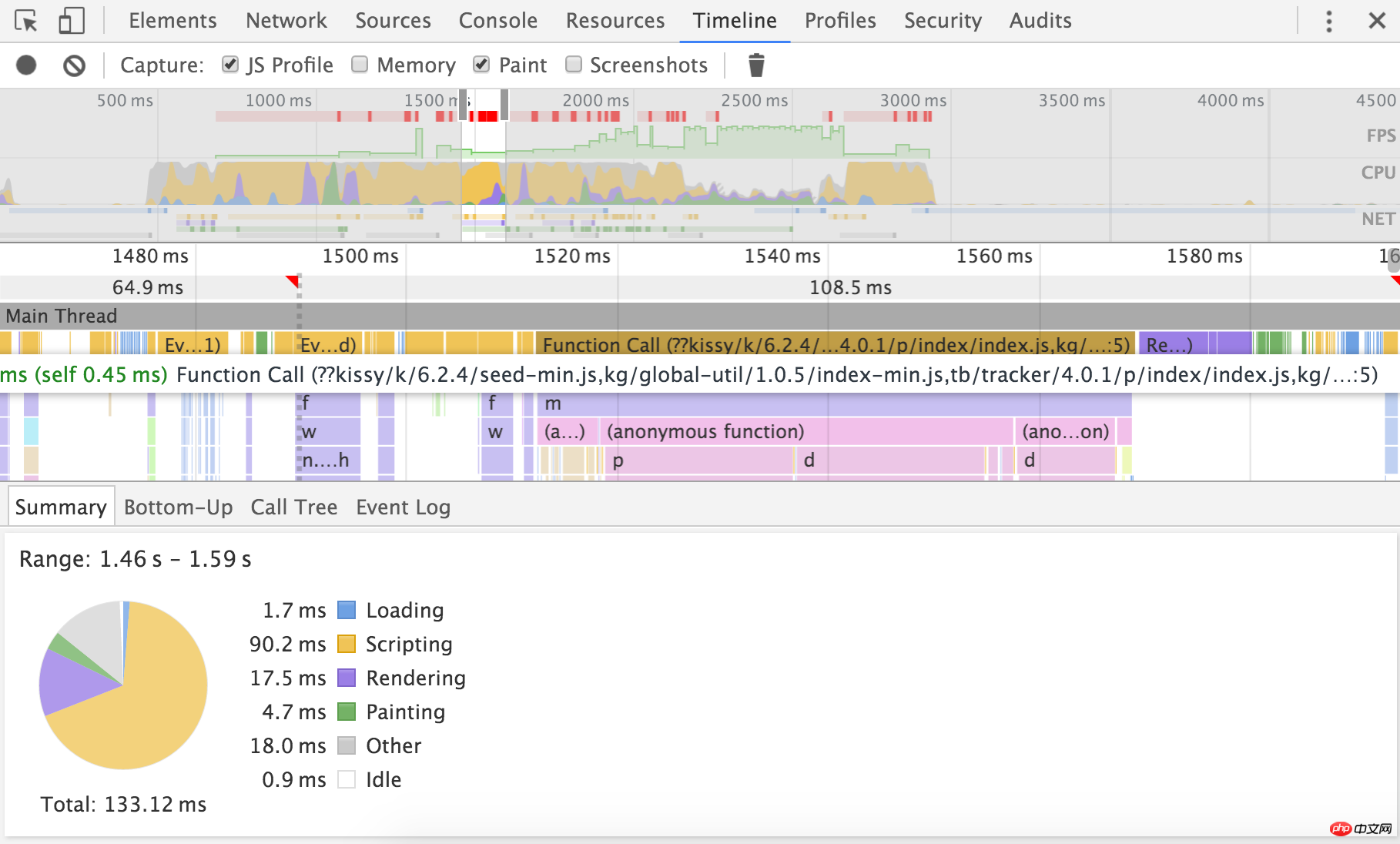The access and opening speed of a website is very important, especially the slow opening and loading of the homepage is fatal. This article introduces a practical case on php website performance optimization: Taobao homepage loading speed optimization practice. I believe many people have seen the new version of Taobao’s homepage. It is different from the past. This version of the page is full of personalized flavor. Due to the unique personalized needs, the front-end is also facing various technical challenges. :
· Multiple data sources
· Serial request to render a module
· Operation Data and personalized data matching and management
· Data disaster recovery
This Taobao homepage revision, although it no longer supports low-version antiques such as IE6 and IE7, browser, but there are still many factors that affect the performance of the homepage:
# relies too much on the system, and the data request is divided into three parts, one of which is static resources (such as js/css/image/iconfont, etc.); the second is the static data pushed to the CDN (such as data filled in by operations, front-end configuration information, etc.); the third is the back-end interface, different modules correspond to different businesses, and There is also a lot of advertising content in the page. It is roughly estimated that there are 8 interface requests issued on the first screen when the page is first loaded. When scrolling to the bottom, more than 20 requests are issued.
Cannot directly output the first screen data. Many data on the first screen are obtained through asynchronous requests. Due to system limitations, these requests are inevitable and the number of requests is relatively large. There are many, which greatly affects the first screen time.
There are too many modules. In order to be able to fill in the data permissions between background isolation operations, the modules must be split into fine-grained parts, as shown in the following figure:
A simple module must be split into multiple small industry modules, as well as other locations on the page, and these split modules may not necessarily be displayed. The algorithm needs to be told to the front-end for display. which modules.
Too many pictures. Turn the page and scroll down. It is obvious that there are pictures that fill the whole screen of the page. Some pictures are filled in by the operation, and some pictures are filled in by the operation. Personalized interface is provided, these pictures have no fixed size.
There are many web page performance measurement indicators. If you can grasp the key ones and focus on optimization, the performance will naturally increase.
One of the indicators that best reflects page performance is FPS (frame per second). Generally, the system sets the screen refresh rate to 60fps. When page elements are animated, scrolled or gradient, they are drawn If the speed is less than 60, it will be unsmooth, if it is less than 24, it will be stuck, and if it is less than 12, it will basically be considered stuck.
1 The duration of the frame is about 16ms. Excluding the system context switching overhead, each frame only leaves us about 10ms of program processing time. If the processing time of a script exceeds 10ms, then this frame can be It is considered lost. If the processing time exceeds 26ms, two consecutive frames can be considered lost, and so on. We cannot tolerate multiple consecutive loss of five or six frames in the page, which means we must find a way to split the code program that takes more than 80ms to execute, which is not an easy task.
When the page first loads, it needs to initialize a lot of programs, and there may also be a lot of time-consuming DOM operations, so the necessary operations in the first 1s will cause the frame rate to be very low, and we can ignore it. Of course, this is for PC. Mobile content is small, and the amount of DOM and JS scripts is much smaller than that of PC. 1s may be a bit long.
The DOMContentLoaded event will be triggered only after the DOM is loaded and parsed. If the source code outputs too much content, the time it takes for the client to parse the DOM will also be lengthened. Don’t underestimate this. Parsing time, if the number of DOMs increases by 2000 and the nesting level is deeper, the parsing time will also increase by 50-200ms. This consumption is actually unnecessary for most pages. Just ensure the first screen output, and subsequent content Only keep hooks and use JS for dynamic rendering.
Load time can be used to measure the total amount of information received by the client during the loading of the first screen. If the first screen is filled with large-size images or the client establishes a large number of connections with the backend, the Load time will also be will be lengthened accordingly.
Fluency is the visual feedback of FPS. The higher the FPS value, the smoother the visual presentation. In order to ensure the loading speed of the page, many contents will not be fully loaded to the client when the page is opened. The fluency mentioned here is the visual buffering during the waiting process. The following is a rendering of the Google Plus page:

The speed of accessing Google from within the wall is not very fast. Many of the contents in the above elements are loaded asynchronously, and it can be seen from the above figure that Google does not make users feel anxious about waiting.
由于平台限制,淘宝首页面临一个先天的性能缺陷,首屏的渲染需要从 7 个不同的后端取数据,这些数据请求是难以合并的,如果用户屏幕比较大,则首屏的面积也比较大,对应的后端平台数据接口就更多。数据是个性化内容或者为广告内容,故请求也不能缓存。
不论用户首屏的面积有多大,保证关键模块优先加载。下面代码片段是初始化所有模块的核心部分:
$('.J_Module').each(function(mod) { var $mod = $(mod); var name = $mod.attr('tms'); var data = $mod.attr('tms-data'); if($mod.hasClass('tb-pass')) {
Reporter.send({
msg: "跳过模块 " + name
}); return;
} // 保证首屏模块先加载
if (/promo|tmall|tanx|notice|member/.test(name)) {
window.requestNextAnimationFrame(function(){ // 最后一个参数为 Force, 强制渲染, 不懒加载处理
new Loader($mod, data, /tanx/.test(name));
});
} else { // 剩下的模块进入懒加载队列 lazyQueue.push({
$mod: $mod,
data: data,
force: /fixedtool|decorations|bubble/.test(name)
});
}
});
TMS 输出的模块都会包含一个 .J_Module 钩子,并且会预先加载 js 和 css 文件。
对于无 JS 内容的模块,会预先打上 tb-pass 的标记,初始化的时候跳过此模块;对于首屏模块关键模块,会直接进入懒加载监控:
// $box 进入浏览器视窗后渲染// new Loader($box, data) ->datalazyload.addCallback($box, function() {
self.loadModule($box, data);
});// $box 立即渲染// new Loader($box, data, true) ->self.loadModule($box, data);
除必须立即加载的模块外,关键模块被加到懒加载监控,原因是,部分用户进入页面就可能急速往下拖拽页面,此时,没必要渲染这些首屏模块。
非关键模块统一送到 lazyQueue 队列,没有基于将非关键模块加入到懒加载监控,这里有两个原因:
一旦加入监控,程序滚动就需要对每个模块做计算判断,模块太多,这里可能存在性能损失
如果关键模块还没有加载好,非关键模块进入视窗就会开始渲染,这势必会影响关键模块的渲染
那么,什么时候开始加载非关键模块呢?
var lazyLoaded = false;function runLazyQueue() { if(lazyLoaded) { return;
}
lazyLoaded = true;
$(window).detach("mousemove scroll mousedown touchstart touchmove keydown resize onload", runLazyQueue); var module; while (module = lazyQueue.shift()) { ~function(m){ // 保证在浏览器空闲时间处理 JS 程序, 保证不阻塞
window.requestNextAnimationFrame(function() { new Loader(m.$mod, m.data, m.force);
});
}(module);
}
}
$(window).on("mousemove scroll mousedown touchstart touchmove keydown resize onload", runLazyQueue);// 担心未触发 onload 事件, 5s 之后执行懒加载队列window.requestNextAnimationFrame(function() {
runLazyQueue();
}, 5E3);
上面的代码应该十分清晰,两种请求下会开始将非关键模块加入懒加载监控:
当页面中触发 mousemove scroll mousedown touchstart touchmove keydown resize onload 这些事件的时候,说明用户开始与页面交互了,程序必须开始加载。
如果用户没有交互,但是页面已经 onload 了,程序当然不能浪费这个绝佳的空档机会,趁机加载内容;经测试,部分情况下,onload 事件没有触发(原因尚不知),所以还设定了一个超时加载,5s 之后,不论页面加载情况如何,都会将剩下的非关键模块加入到懒加载监控。
如果说上面的优化叫做懒加载,那么这里的优化可以称之为懒执行。
首页上有几个模块是包含交互的,如头条区域的 tab ,便民服务的浮层和主题市场的浮层,部分用户进入页面可能根本不会使用这些功能,所以程序上并没有对这些模块做彻底的初始化,而是等到用户 hover 到这个模块上再执行全部逻辑。
首屏中有两个次要请求,一个是主题市场的 hot 标,将用户最常逛的三个类目打标;第二个是个人中心的背景,不同的城市会展示不同的背景图片,这里需要请求拿到城市信息。
这两处的渲染策略都是,在程序的 idle(空闲)时期,或者 window.onload 十秒之后去请求,然后将请求的结果缓存到本地,当用户第二次访问淘宝首页时能够看到效果。这是一种更懒的执行,用户刷新页面才看得到.这种优化是产品能够接受,也是技术上合理的优化手段。
不论图片链接的来源是运营填写还是接口输出,都难以保证图片具备恰当的宽高,加上如今 retina 的屏幕越来越多,对于这种用户也要提供优质的视觉体验,图片这块的处理并不轻松。
<img src='//g.alicdn.com/s.gif' src='//g.alicdn.com/real/path/to/img.png' / alt="PHP website performance optimization practice: Taobao homepage loading speed optimization practice" >
阿里 CDN 是支持对图片尺寸做压缩处理的,如下图为 200×200 尺寸的图片:
加上 _100x100.jpg 的参数后,会变成小尺寸:
我们知道 webp 格式的图片比对应的 jpg 要小三分之一,如上图加上 _.webp 参数后:
视觉效果并没有什么折扣,但是图片体积缩小了三分之一,图片越大,节省的越明显。显然,淘宝首页的所有图片都做了如上的限制,针对坑位大小对图片做压缩处理,只是这里需要注意的是,运营填写的图片可能已经是压缩过的,如:
$img = '//g.alicdn.com/real/path/to/img.png_400x400.jpg';<img alt="PHP website performance optimization practice: Taobao homepage loading speed optimization practice" >
上面这种情况,图片是不会正确展示的。首页对所有的图片的懒加载都做了统一的函数处理:
src = src.replace(/\s/g, '');var arr;if (/(_\d{2,}x\d{2,}\w*?\.(?:jpg|png)){2,}/.test(src) && src.indexOf('_!!') == -1) {
arr = src.split('_'); if (arr[arr.length - 1] == '.webp') {
src = [arr[0], arr[arr.length - 2], arr[arr.length - 1]].join('_');
} else {
src = [arr[0], arr[arr.length - 1]].join('_');
}
}if (src.indexOf('_!!') > -1) {
src = src.replace(/((_\d{2,}x\d{2,}[\w\d]*?|_co0)\.(jpg|png))+/, '$1');
}
WebP.isSupport(function(isSupportWebp) { // https 协议访问存在问题 IE8,去 schema
if (/^http:/.test(src)) {
src = src.slice(5);
} // 支持 webp 格式,并且 host 以 taobaocdn 和 alicdn 结尾,并且不是 s.gif 图片
if (isSupportWebp && /(taobaocdn|alicdn)\.com/.test(src) && (src.indexOf('.jpg') ||
src.indexOf('.png')) && !/webp/.test(src) && !ignoreWebP && !/\/s\.gif$/.test(src)) {
src += '_.webp';
}
$img.attr('src', src);
});
模块去钩子,走配置
TMS 的模块在输出的时候会将数据的 id 放在钩子上:
<p></p>
如果模块是异步展示的,可以通过 tms-datakey 找到模块数据,而首页的个性化是从几十上百个模块中通过算法选出几个,如果把这些模块钩子全部输出来,虽说取数据方便了很多,却存在大量的冗余,对此的优化策略是:将数据格式相同的模块单独拿出来,新建页面作为数据页。所以可以在源码中看到好几段这样的配置信息:
<textarea>[{"backup":"false","baseid":"1","mid":"222726","name":"iFashion","per":"false","tid":"3","uid":"1000"},{"backup":"false","baseid":"3","mid":"222728","name":"美妆秀","per":"false","tid":"3","uid":"1001"},{"backup":"false","baseid":"4","mid":"222729","name":"爱逛街","per":"false","tid":"4","uid":"1002"},{"backup":"false","baseid":"2","mid":"222727","name":"全球购","per":"false","tid":"4","uid":"1003"}]</textarea>
减少了大量的源码以及对 DOM 的解析。
有一些模块数据是很少被修改的,比如接口的兜底数据、阿里 APP 模块数据等,可以通过调整参数,设置模块的缓存时间,如:
io({
url: URL,
dataType: 'jsonp',
cache: true,
jsonpCallback: 'jsonp' + Math.floor(new Date / (1000 * 60)),
success: function() { //... }
});
Math.floor(new Date / (1000 * 60)) 这个数值在一分钟内是不会发生变化的,也就是说将这个请求在本地缓存一分钟,对于低频修改模块,缓存时间可以设置为一天,即:
Math.floor(new Date / (1000 * 60 * 60 * 24))
当然,我们也可以采用本地储存的方式缓存这个模块数据:
offline.setItem('cache-moduleName', JSON.stringify(data), 1000 * 60 * 60 * 24);
缓存过期时间设置为 1 天,淘宝首页主要采用本地缓存的方式。
这方面的优化不是很多,但是也有一点效果,很多模块的展示并不是干巴巴的 .show(),而是通过动画效果,缓动呈现,这方面的优化推荐使用 CSS3 属性去控制,性能消耗会少很多。
页面优化的切入点很多,我们不一定能够面面俱到,但是对于一个承载较大流量的页面来说,下面几条必须有效执行:
首屏一定要快
滚屏一定要流畅
能不加载的先别加载
能不执行的先别执行
渐进展现、圆滑展现
当然,性能优化的切入角度不仅仅是上几个方面,对照 Chrome 的 Timeline 柱状图和折线图,我们还可以找到很多优化的点,如:

在 1.0s 左右存在一次 painting 阻塞,可能因为一次性展示的模块面积过大
从 FPS 的柱状图可以看出,在 1.5s-2.0s 之间,存在几次 Render 和 JavaScript 丢帧
从多出的红点可以看出页面 jank 次数,也能够定位到代码堆栈
在优化的过程中需要更多地思考,如何让阻塞的脚本分批执行,如何将长时间执行的脚本均匀地分配到时间线上。这些优化都体现在代码的细节上,宏观上的处理难以有明显的效果。当然,在宏观上,淘宝首页也有一个明显的优化:\
// https://gist.github.com/miksago/3035015#file-raf-js(function() { var lastTime = 0; var vendors = ['ms', 'moz', 'webkit', 'o']; for(var x = 0; x <p>这段代码基本保证每个模块的初始化都是在浏览器空闲时期,减少了很多不必要的丢帧。这个优化也可以被应用到每个模块的细节代码之中,不过优化难度会更高。</p><h2>小结</h2><p>代码的性能优化是一个精细活,如果你要在一个庞大的未经优化的页面上做性能优化,可能会面临一次重构代码。本文从php网站性能优化引出的问题出发,依实战淘宝首页速度优化提升实战为案例,从微观到宏观讲述了页面的优化实践,提出了几条可以借鉴的优化标准,希望对你有所启发。优化的细节点描述的不够完善也不够全面,但是都是值得去优化的方向。</p><p>相关文章:</p><p><a href="//m.sbmmt.com/php-weizijiaocheng-357241.html" target="_self">大型php网站性能和并发访问优化方案</a></p>